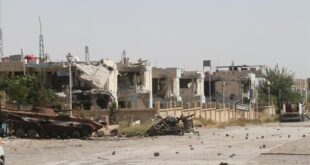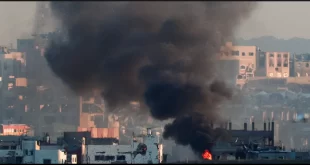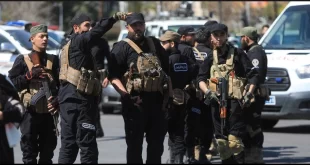
From Mount Qasioun overlooking Damascus. [Johnny Achi]
by Johnny Achi
In my 30 years living in the US I have probably visited Syria around 20 or so times, none as eventful, exciting, or as emotional as my recent trip that I had just returned from. Here is a summary of six-weeks in the life of Syria through my own eyes.
First week: relative calm in Damascus, sectarian crimes committed against Syrians across the country:
Horrific massacres carried out by the Nusra Front rebels against Syrian Alaouites in the northern coastal city of Latakia, followed by a massacre against the Syrian Kurdish population in the northern eastern part of the country, followed by a massacre against Syrian Christians in Wadi al-Nasarah in the middle of the country. These sectarian crimes were aimed at driving the minorities to avenge their losses and thus turning the crisis into a sectarian civil war, like they have been advertising it to be, or to drive the minorities out of their areas as part of Nusra’s ethnic cleansing tactic. Neither happened!
Second week: A higher frequency of the indiscriminate shelling of Damascus by the rebels:
The rocket-propelled grenades fired by the rebels were raining down at Damascus at a noticeably increased rate, and were targeting primarily the ‘al-Qassa’ residential neighborhood. Not sure whether it was targeted because of its Christian dominated population, or because of its proximity to the terrorist rebels held areas. Miraculously, with an average of a dozen rockets falling daily, few casualties were reported comparing to the number of rockets falling. One rocket missed my brother and I by about 50 meters as we were turning the corner into George Khoury’s Square, another struck within minutes after leaving a place we were dining in. Unfortunately, not everyone was as lucky, one of the casualties was a family friend, he was in the kitchen of his home with his wife making cake for his two young children who were in the adjacent living room when the rocket came through the kitchen window and killed him instantly, his wife and children survived their injuries.
Third week: Aug. 21st, the chemical attack saga, and the US threat of bombing Syria:
Everyone knew that the terrorists were the culprits in ‘Ghouta’, not the Syrian government. They have been losing the ground war against Syrian government forces for months, and they knew that the use of chemical weapons was the “red line” that Obama had set as the threshold for military intervention. Not to mention the obvious forgery in the videos Kerry used to condemn the Syrian government, and the conflicting reports about the number of casualties, British intelligence had put the number of people killed in the attack at about 350, the French based Médecins Sans Frontières (Doctors without Borders) put the death toll at 355. The Britain-based Syrian Observatory for Human Rights raised their numbers from 136 to 322 including 54 children. However president Obama spoke of over a thousand murdered, and John Kerry was quoted using an astonishing figure of 1429, he said more than 400 of them children! The following video, clearly show the staging of the chemical attack. http://www.youtube.com/watch?v=EzLVfdrQRsY
Those who argue president Assad’s culpability have to believe that not only did he suddenly and inexplicably resort to using chemical weapons on his own people for no strategic military reason, but that he waited until UN chemical weapons inspectors, whom the Syrian government requested, arrived in the country before doing so.
What was very significant about this week was that people form outside of Syria were worried about people inside of Syria more than the people inside of Syria themselves. On the eve of the supposed US bombing, I received calls from just about every friend in the US asking me to leave Syria immediately. While the outside world was almost certain about a US strike that night, the majority of Syrians seemed to be oblivious and unconscious of the danger. Unlike what was happening in neighboring Occupied-Palestine (Israel), Syrians were not in shelters, they were out in the streets, in coffee shops, and some actually on the roofs in anticipation of them tomahawks.
The following two weeks: Media hype and the campaign ‘US Congress: Act for Peace, Vote No to war against Syria’:
While Syrians have for two and a half years been living through an internal conflict and a brutal ground war by dozen countries by proxy using jihadists, and mercenaries form all over the world, and surviving a propaganda war full of lies and deception by the world mainstream media, had to now endure yet another war, a psychological one by Obama on whether he will or will not bomb the Syrian people. As evidence started to mount pointing out that the US-backed rebels are the ones behind the chemical attack http://www.infowars.com/rebels-admit-responsibility-for-chemical-weapons-attack/ Obama had to back down by throwing the ball in the lap of congress. A small group of young Syrians started the group ‘US Congress: Act for Peace. Vote No to war against Syria’, and within days the small group grew to over 30 thousand members, and Syrian patriots and anti-war activists from around the world started contacting the offices of all 435 US congressmen/women, and all 100 US senators through phone calls, emails, and FB and Twitter accounts to urge them to vote NO on War against Syria. The campaign was such a great success that ‘The NY Times’ wrote about it, publishing the link of the campaign’s FB page. http://www.nytimes.com/2013/09/09/world/middleeast/on-both-sides-syrians-make-pleas-to-us.html?pagewanted=all&_r=1&The most noticeable and important factor of the week was the mainstream media’s sudden interest in hearing the Syrian ‘other point of view’. I was receiving calls from various news organization on my Syrian cell phone and was conducting at least one interview and up to three a day. Perhaps it was due to the overwhelming success of the campaign, or perhaps as a way to bail out Obama by unleashing the media to shed some lights on the documented barbaric and criminal behavior of the US-backed armed rebels to sway public opinion against the strike. Bashar Jaafari, Syria’s ambassador to the United Nations said it best: Both Obama and Cameron, he said, “climbed to the top of the tree and don’t know how to get down.” From Damascus we were interviewed by RT, BBC, The NY Times, CBC Canada, Sunday Times, and many more.
Final week: US peace delegation visited Syria:
As the drums of war seemed to weaken to the sound of reason and to the shouts of antiwar movement in the US and elsewhere in the world, a US peace delegation visiting Syria and saying No to war couldn’t have come at a better time. After attending the Arab International Forum Against US Aggression on Syria organized by the Arab International Center for Communication and Solidarity in Beirut, Lebanon, I returned to Syria with former US Attorney General and human rights lawyer Ramsey Clark, and six-terms congresswoman from Georgia Cynthia McKinney, International Action Center co-director Sara Flounders, IAC West Coast director John Parker, and Dedon Kamathi of the All African People’s Revolutionary Party and KPFK Radio Pacifica Host, to show people-to-people solidarity with Syria and to counter the incessant war propaganda spread in the U.S.
The three days visit included a fact-finding mission, visits to shelters and displacement centers, meeting victims of kidnapping and sectarian crimes, visit to hospitals and meeting injured soldiers. The trip also included a visit with Grand Mufti Hassoun, the Greek Orthodox Patriarch, and other religious and political officials capped off with a meeting with the country’s president Dr. Bashar al-Assad. The delegation also visited members of the campaign ‘US Congress: Act for Peace, Vote NO against War on Syria’ and also paid a visit to Mount Qasioun and met with Ogarite Dandache, and members of ‘Over Our Dead Bodies’ campaign.
An exceptional week filled with tears and smiles, filled with sorrow yet also hope and aspiration, filled with pain yet so much thankfulness. Through it all you come to the conclusion that while Syria might be very diverse, ethnically and religiously, Syrians will always rush to the aid of one another. Syria is very unique in that regard and will always be strong and the Syrian people will overcome, and will continue to always be united.
I am here back safely in the US now, yet my heart and mind are with those young soldiers who are standing on the gates of Damascus ready to die to defend the city, my heart is with the young injured soldiers laying in hospital beds recuperating from a a bullet or a rocket shrapnel wound, waiting to get better to rejoin their comrades in arms. My heart is also with the young displaced children and families who we met, each with a story that breaks the heart. My heart is with the family of the martyrs, a father who lost 2 children and still have two more in active duty, both volunteered, told me they’re ready to follow in their brothers’ foot steps. My heart is with the young men and women on the top of Mount Qasioun camped out since late August, using their bodies as human shields in defiant resistance to any war against Syria. “Mount Qasioun should be the site of a peace party not bombing strikes” said to me Mrs. McKinney. To all those and to the many more I’ve met on this trip, I say despite all that is happening in Syria today, I have never been prouder to say I am Syrian.

Visiting with injured soldiers. [Johnny Achi]

At Martyr Yusuf al-Azma hospital in Damascus. [Johnny Achi]

Anti-war delegation from U.S. meet with Syrian youth at their ‘Over Our Dead Bodies’ encampment on Mount Qasioun outside Damascus [Johnny Achi]

US peace delegation pay a visit to a shelter of the displaced and affected families in Dumar neighborhood. [Johnny Achi]

A true honor to have received the Shield of Peace Award at the Arab International Center for Communication and Solidarity in Beirut, Lebanon. [Johnny Achi]

Visiting with his eminence Grand Mufti Sheikh Ahmad Hassoun [Johnny Achi]
 Syria Support Movement solidarity with the Syrian people
Syria Support Movement solidarity with the Syrian people




